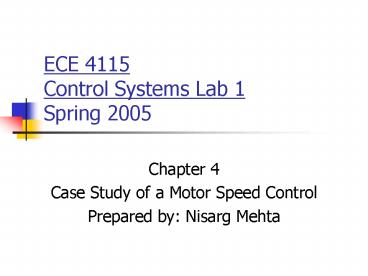ECE 4115 Control Systems Lab 1 Spring 2005 - PowerPoint PPT Presentation
1 / 32
Title:
ECE 4115 Control Systems Lab 1 Spring 2005
Description:
ECE 4115 Control Systems Lab 1 Spring 2005 Chapter 4 Case Study of a Motor Speed Control Prepared by: Nisarg Mehta Matlab Start Run \\laser\apps Open MatlabR14 and ... – PowerPoint PPT presentation
Number of Views:132
Avg rating:3.0/5.0
Title: ECE 4115 Control Systems Lab 1 Spring 2005
1
ECE 4115Control Systems Lab 1Spring 2005
- Chapter 4
- Case Study of a Motor Speed Control
- Prepared by Nisarg Mehta
2
Matlab
- Start ? Run ? \\laser\apps
- Open MatlabR14 and double click on MATLAB 7.0.1
3
Summary of Course
- Introduction to MATLAB
- Chapter 1 System Models
- Chapter 2 Time Response of Systems
- Chapter 3 Frequency Domain Analysis and Design
- Case Study of a Motor Speed Control
4
Summary of Chapter 1System Models
- Basic types of LTI models
- Transfer Function tf, tfdata
- Zero-pole-gain model zpk, zpkdata
- Conversion between models
- Model dynamics pzmap, pole, eig, zero, dcgain
5
Summary of Chapter 2Time Response of System
- Impulse response Impulse
- Step response Step
- General time response lsim
- Polynomial multiplication conv
- Polynomial division deconv
- Partial fraction expansion residue
6
Summary of Chapter 3Frequency Domain Analysis
and Design
- Root locus analysis (rlocus, rlocfind)
- Frequency response plots
- Bode (bode)
- Gain Margin (margin)
- Phase Margin (margin)
- Nyquist (nyquist)
7
Presentations
- http//www.egr.uh.edu/courses/ECE/
8
Case StudyMotor Speed Control
- Modeling
- Time response
- PID controller design
- Root locus controller design
- Frequency based controller design
9
Programs
- Open_loop_response
- P_response
- PI_response
- PID_response
- Open_loop_rootlocus
- PID_rootlocus
- Open_loop_bode
- PID_bode
10
Motor Speed Control
- A DC motor has second order speed dynamics
- Mechanical properties such as inertia (J) and
damping (b) - Electrical properties such as inductance (L) and
resistance (R) - Controller's objective is to maintain the speed
of rotation of the motor shaft with a particular
step response
11
Modeling
- The electric circuit of the armature and the free
body diagram of the rotor are shown
12
Modeling
- moment of inertia of the rotor (J) 0.01
kg.m2/s2 - damping ratio of the mechanical system (b) 0.1
Nms - electromotive force constant (KKeKt) 0.01
Nm/Amp - electric resistance (R) 1 ohm
- electric inductance (L) 0.5 H
- input (V) Source Voltage
- output (theta) position of shaft
- The rotor and shaft are assumed to be rigid
13
Modeling
- The motor torque, T, is related to the armature
current, i, by a constant factor Kt - The back emf, e, is related to the rotational
velocity by the following equations
14
Modeling Transfer Function
- Based on Newton's law combined with Kirchhoff's
law
15
Modeling Transfer Function
- Using Laplace Transforms
16
Open Loop Response
17
Open Loop Response
- 1 volt is applied to the system, the motor
position changes by 70 radians in 2 seconds - Motor doesn't reach a steady state
18
PID Design Method
- With a 1 rad/sec step input, the design criteria
are - Settling time less than 0.04 seconds
- Overshoot less than 16
- No steady-state error
19
PID Controller
- Proportional Controller with gain Kp 100
- PID controller with gains Kp 100, Ki 1 and Kd
1 - Tune the gain Ki 200
- Increase Kd to reduce over shoot Kd 10
20
Proportional Gain (Kp 1.7)
21
Proportinal-Integral Controller (Kp 1.7, Ki
20)
22
Proportional-Integral-Derivative Controller
23
Open loop Root Locus
24
Root Locus Design
- With a 1 rad/sec step reference, the design
criteria are - Settling time less than 0.04 seconds
- Overshoot less than 16
- No steady-state error
25
Finding the gain
26
Plot the step response
27
Drawing the original Bode plot
28
Frequency Design Method for DC Motor Speed Control
29
Summary of Case StudyDC Motor Control
- Modeling of DC Motor
- Design of PID controller
- Design of Controller using Rootlocus
- Design of Controller using Frequency response
30
Summary of Course
- Introduction to MATLAB
- Chapter 1 System Models
- Chapter 2 Time Response of Systems
- Chapter 3 Frequency Domain Analysis and Design
- Case Study of a Motor Speed Control
31
Project Model Reduction and Control systems
Design
- Abstract
- Introduction
- Theoretical Development
- Illustrative Examples
- Model Reduction
- Control System Design
- Conclusion and Discussion
- References
32
Thank you
- Homework 3 and Final Project
- Due on April 20th































